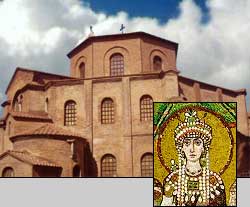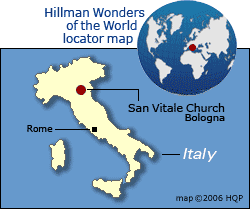San Vitale Basilica
 Why the
San Vitale Basilica
is special
Why the
San Vitale Basilica
is specialIts mosaics are the finest, best-preserved, and most significant early-Christian mosaics in Europe. The interior Byzantine architectural setting enhances their intrinsic quality.
San Vitale Basilica tips and insights
Why the building and mosaics are decidedly Byzantine
The church was built in the 6th century when the Byzantine Empire controlled the region.
Why did the church choose mosaics over paintings?
The structure is slowly sinking into the ground and has been for centuries. This creates excessive humidity. Fortunately, the designers elected to use mosaics as the artistic medium. Mosaics last much longer than frescos in an enclosed moist-air environment.
Some other insights on the mosaics
The mosaics are vibrant and expertly orchestrated. The artists placed some tiles at a slight angle to create special color effects. Two of the main mosaics prominently feature the Byzantium Emperor Justinian and his wife Theodora. Mosaic appreciators will also enjoy visiting the nearby Mausoleum of Galla Placidia.
There's another San Vitale Basilica
Rome, too, has a venerable San Vitale Basilica - which has led to confusion among tourists. The Rome version is notable but not as outstanding as Ravenna's.
Location in Italy



